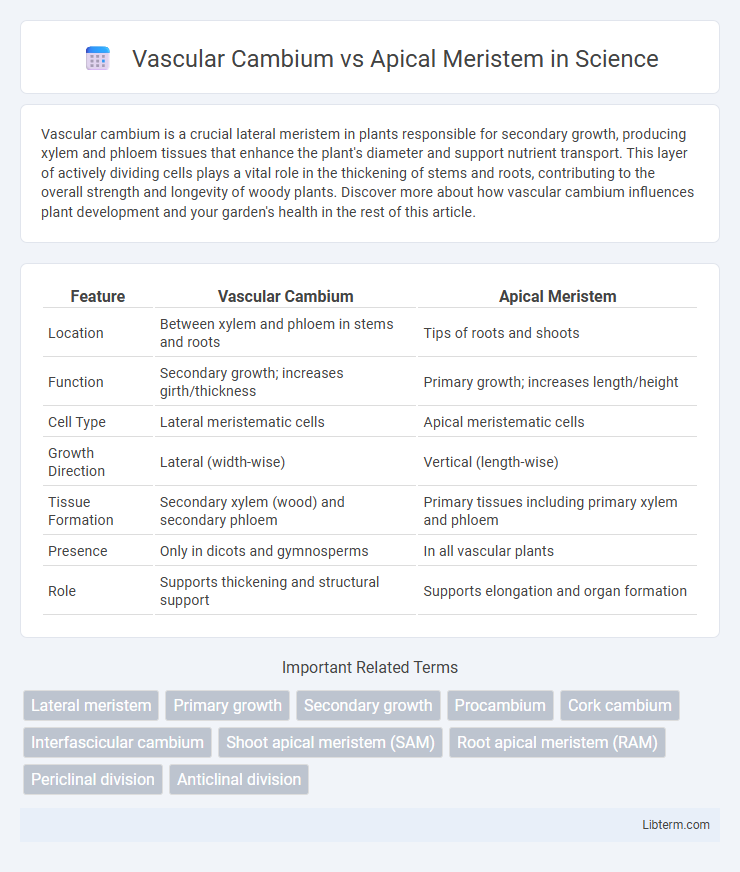Vascular cambium is a crucial lateral meristem in plants responsible for secondary growth, producing xylem and phloem tissues that enhance the plant's diameter and support nutrient transport. This layer of actively dividing cells plays a vital role in the thickening of stems and roots, contributing to the overall strength and longevity of woody plants. Discover more about how vascular cambium influences plant development and your garden's health in the rest of this article.
Table of Comparison
| Feature | Vascular Cambium | Apical Meristem |
|---|---|---|
| Location | Between xylem and phloem in stems and roots | Tips of roots and shoots |
| Function | Secondary growth; increases girth/thickness | Primary growth; increases length/height |
| Cell Type | Lateral meristematic cells | Apical meristematic cells |
| Growth Direction | Lateral (width-wise) | Vertical (length-wise) |
| Tissue Formation | Secondary xylem (wood) and secondary phloem | Primary tissues including primary xylem and phloem |
| Presence | Only in dicots and gymnosperms | In all vascular plants |
| Role | Supports thickening and structural support | Supports elongation and organ formation |
Introduction to Plant Meristems
Plant meristems are regions of actively dividing cells responsible for growth and development. Vascular cambium, a lateral meristem, contributes to secondary growth by producing xylem and phloem, increasing stem girth. Apical meristem, located at root and shoot tips, drives primary growth by extending plant length through new cell formation.
What is Vascular Cambium?
Vascular cambium is a lateral meristem responsible for secondary growth in plants, producing secondary xylem (wood) inward and secondary phloem outward. It forms a continuous ring between the primary xylem and primary phloem in stems and roots. This meristematic tissue plays a crucial role in increasing the girth of woody plants, enhancing structural support and transport capacity.
What is Apical Meristem?
Apical meristem is a region of actively dividing cells located at the tips of roots and shoots, responsible for primary growth in plants by elongating stems and roots. It produces new cells that differentiate into various tissues, enabling the plant to extend its height and depth. Unlike vascular cambium, which contributes to secondary growth by increasing girth, apical meristem drives vertical growth and the formation of primary tissues.
Structural Differences Between Vascular Cambium and Apical Meristem
Vascular cambium is a lateral meristem producing secondary xylem and phloem, characterized by a cylindrical layer of actively dividing cells between the primary xylem and phloem, facilitating secondary growth in woody plants. Apical meristem, located at the shoot and root tips, is responsible for primary growth and elongation, consisting of small, densely packed cells with prominent nuclei and thin cell walls. Structurally, vascular cambium cells are arranged in a continuous ring, while apical meristem cells form a compact dome-shaped cluster at growth tips.
Functional Roles in Plant Growth
Vascular cambium functions primarily in secondary growth by producing secondary xylem and phloem, increasing the girth of stems and roots. Apical meristem is responsible for primary growth, enabling elongation of shoots and roots through the division of cells at tips. Together, these meristems coordinate vertical and radial expansion essential for plant development and biomass accumulation.
Location in Plant Organs
Vascular cambium is located between the xylem and phloem in the stems and roots of dicotyledonous plants, contributing to secondary growth and increasing the thickness of these organs. Apical meristem is found at the tips of roots and shoots, driving primary growth by elongating the plant vertically. These distinct locations enable vascular cambium and apical meristem to support different growth patterns in plant development.
Types of Cells Produced
Vascular cambium primarily produces secondary xylem (wood) and secondary phloem, facilitating the thickening of stems and roots. Apical meristem generates primary tissues including primary xylem, primary phloem, and ground tissues, contributing to the elongation of roots and shoots. While vascular cambium forms lateral meristem tissue, apical meristem represents the primary growth region at root and shoot tips.
Importance in Primary vs. Secondary Growth
Vascular cambium plays a crucial role in secondary growth by producing secondary xylem and phloem, which increase the thickness of stems and roots. Apical meristem is essential for primary growth, responsible for elongation of shoots and roots through cell division at the tips. Understanding the distinct functions of vascular cambium and apical meristem is vital for comprehending plant development and growth patterns.
Evolutionary Significance of Meristems
Vascular cambium and apical meristem represent key evolutionary adaptations in plants, enabling continuous growth and development throughout their lifespan. The apical meristem, located at root and shoot tips, facilitates primary growth by producing cells for elongation, crucial for early plant development and vertical growth. Vascular cambium, found in woody plants, drives secondary growth by generating vascular tissues like xylem and phloem, supporting increased girth and structural complexity that allowed plants to colonize diverse terrestrial environments.
Key Differences and Summary Table
Vascular cambium is a lateral meristem responsible for secondary growth, producing secondary xylem and phloem, while the apical meristem is a primary meristem located at root and shoot tips, driving primary growth by increasing length. Vascular cambium cells divide to expand the girth of stems and roots, whereas apical meristem cells divide to elongate the plant body and form new organs like leaves and flowers. The summary table highlights differences in location (lateral vs apical), growth type (secondary vs primary), and tissue produced (vascular tissues vs all primary tissues).
Vascular Cambium Infographic

 libterm.com
libterm.com